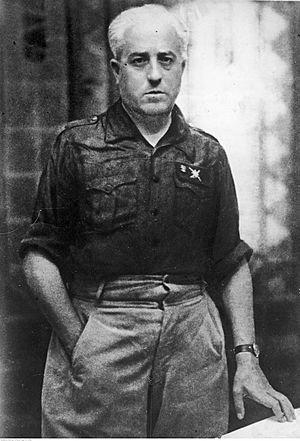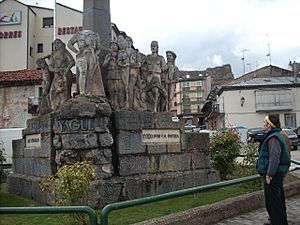Juan Yagüe facts for kids
Quick facts for kids
Juan Yagüe
|
|
|---|---|
 |
|
| Birth name | Juan Yagüe y Blanco |
| Nickname(s) | Butcher of Badajoz |
| Born | 19 November 1891 San Leonardo de Yagüe, Kingdom of Spain |
| Died | 21 October 1952 (aged 60) Burgos, Francoist Spain |
| Allegiance | |
| Service/ |
Spanish Army Spanish Legion |
| Years of service | 1907–1952 |
| Rank | Captain General |
| Commands held | Military Commander of Melilla Captain General of the VI Military Region |
| Battles/wars | Rif War Spanish Civil War |
| Awards | Military Medal |
Juan Yagüe y Blanco, 1st Marquis of San Leonardo de Yagüe (born November 19, 1891 – died October 21, 1952) was an important military officer in Spain. He served during the Spanish Civil War as a leader on the Nationalist side. He was a key figure in many battles during this time.
Contents
Early Life and Military Training
Juan Yagüe was the son of a doctor. He joined the Toledo Infantry Academy when he was young. There, he met Francisco Franco, who also became a famous general. Both men started their military careers at the same time.
They served together in Africa. Yagüe was hurt several times during his service. He also received many awards for his bravery. In 1932, he was promoted to lieutenant colonel.
In 1934, Yagüe helped put down a workers' protest in Asturias. He worked with Franco and General Eduardo López Ochoa. They used soldiers from Morocco and the Spanish Legion for this task. Yagüe was also a strong supporter of the Falange Española, a political group. He was a close friend of its leader, José Antonio Primo de Rivera.
The Spanish Civil War Begins
In May 1936, the president of Spain, Niceto Alcalá-Zamora, was replaced. The new president was Manuel Azaña, from a left-wing political party. After this, a group of Spanish Army officers began to plan. Juan Yagüe was part of this group. Other officers included Emilio Mola, Franco, Gonzalo Queipo de Llano, and José Sanjurjo.
Their plan was to take control of the government. This led to a military uprising on July 17, 1936. This event marked the start of the Spanish Civil War.
Key Battles and Campaigns
Yagüe's forces began their revolt in Ceuta. They then crossed the Straits of Gibraltar. They joined up with other Nationalist forces in Seville. These forces were led by Queipo de Llano.
Yagüe then moved his troops north. First, they took control of Mérida in the Battle of Mérida. After that, they attacked Badajoz on August 14, 1936. About 3,000 of Yagüe's troops were involved. There was intense fighting in the streets as the Nationalist forces entered the city.
Yagüe's forces eventually took control of Badajoz. Both sides had many casualties. After the city was taken, many people in Badajoz lost their lives. This event is sometimes called the Badajoz massacre.
After Badajoz, Yagüe was promoted to colonel. He then moved towards Madrid, the capital city. His forces captured Trujillo, Navalmoral de la Mata, and Talavera de la Reina. However, they were not able to take Madrid.
Yagüe also played a role in the Aragon Offensive. He helped capture Belchite, Caspe, and Lérida. He was also very important in the Nationalist victory at the Battle of the Ebro.
In May 1938, Yagüe was briefly removed from his command. He was put in prison because he made some comments that criticized Franco. However, he was back fighting on the front lines within a few weeks. It was said that he was the only Spanish commander that the German Condor Legion respected. Yagüe was known for staying calm even when the enemy was close. He could also quickly change battle plans when needed.
After the War
After the Second Spanish Republic fell in 1939, Yagüe received another promotion. He became a major-general. General Franco also appointed him as the Minister of the Air Force.
In 1942, he was made a lieutenant general. After his death, he was given a final promotion to commander-in-chief.
See also
 In Spanish: Juan Yagüe para niños
In Spanish: Juan Yagüe para niños


